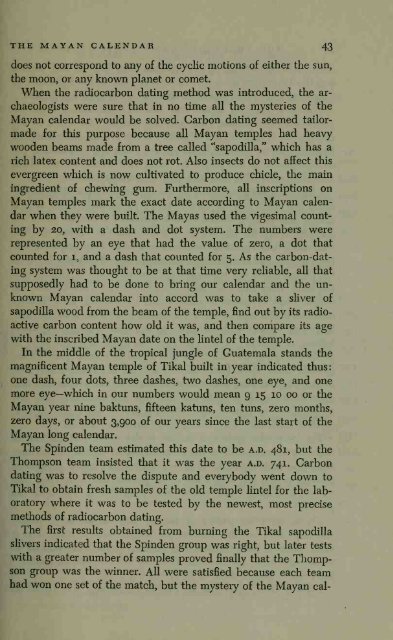Create successful ePaper yourself
Turn your PDF publications into a flip-book with our unique Google optimized e-Paper software.
THE MAYAN CALENDAR 43<br />
does not correspond to any of the cyclic motions of either the sun,<br />
the moon, or any known planet or comet.<br />
When the radiocarbon dating method was introduced, the archaeologists<br />
were sure that in no time all the mysteries of the<br />
Mayan calendar would be solved. Carbon dating seemed tailormade<br />
for this purpose because all Mayan temples had heavy<br />
wooden beams made from a tree called "sapodilla," which has a<br />
rich latex content and does not rot. Also insects do not affect this<br />
evergreen which is now cultivated to produce chicle, the main<br />
ingredient of chewing gum. Furthermore, all inscriptions on<br />
Mayan temples mark the exact date according to Mayan calendar<br />
when they were built. The Mayas used the vigesimal counting<br />
by 20, with a dash and dot system. The numbers were<br />
represented by an eye that had the value of zero, a dot that<br />
counted for i, and a dash that counted for 5. As the carbon-dating<br />
system was thought to be at that time very reliable, all that<br />
supposedly had to be done to bring our calendar and the unknown<br />
Mayan calendar into accord was to take a sliver of<br />
sapodilla wood from the beam of the temple, find out by its radioactive<br />
carbon content how old it was, and then compare its age<br />
with the inscribed Mayan date on the lintel of the temple.<br />
In the middle of the tropical jungle of Guatemala stands the<br />
magnificent Mayan temple of Tikal built in year indicated thus:<br />
one dash, four dots, three dashes, two dashes, one eye, and one<br />
more eye—which in our numbers would mean 9 15 10 00 or the<br />
Mayan year nine baktuns, fifteen katuns, ten tuns, zero months,<br />
zero days, or about 3,900 of our years since the last start of the<br />
Mayan long calendar.<br />
The Spinden team estimated this date to be a.d. 481, but the<br />
Thompson team insisted that it was the year a.d. 741. Carbon<br />
dating was to resolve the dispute and everybody went down to<br />
Tikal to obtain fresh samples of the old temple lintel for the laboratory<br />
where it was to be tested by the newest, most precise<br />
methods of radiocarbon dating.<br />
The first results obtained from burning the Tikal sapodilla<br />
slivers indicated that the Spinden group was right, but later tests<br />
with a greater number of samples proved finally that the Thompson<br />
group was the winner. All were satisfied because each team<br />
had won one set of the match, but the mystery of the Mayan cal-

















